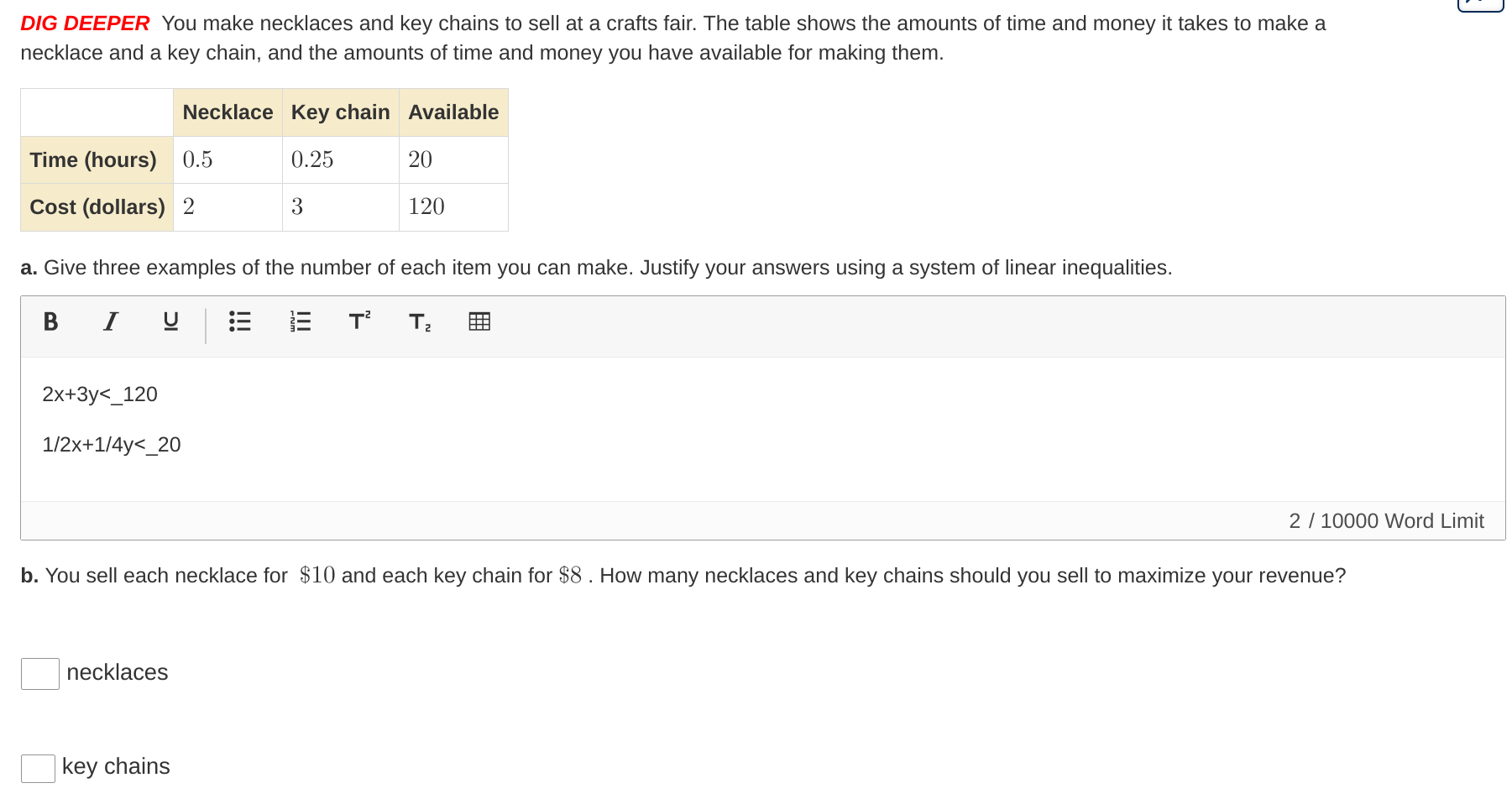You make necklaces and key chains to sell at a crafts fair. The table shows the amounts of time and money it takes to make a necklace and a key chain, and the amounts of time and m... You make necklaces and key chains to sell at a crafts fair. The table shows the amounts of time and money it takes to make a necklace and a key chain, and the amounts of time and money you have available for making them. a. Give three examples of the number of each item you can make. Justify your answers using a system of linear inequalities. b. You sell each necklace for $10 and each key chain for $8. How many necklaces and key chains should you sell to maximize your revenue?

Understand the Problem
The question is asking for a solution involving the creation of necklaces and key chains based on given constraints of time and money. It requires the formulation of linear inequalities and maximizing revenue from sales.
Answer
Produce $20$ necklaces and $0$ key chains to maximize revenue.
Answer for screen readers
To maximize revenue with the constraints, you can produce:
- Necklaces: 20
- Key chains: 0
Resulting in a maximum revenue of: $$ R = 10(20) + 8(0) = 200 $$
Steps to Solve
- Set Up Variables
Define the variables for the items being made:
- Let ( x ) = number of necklaces
- Let ( y ) = number of key chains
- Establish Inequalities from Constraints
From the problem statement, create inequalities based on time and cost:
-
Time Constraint: Each necklace takes 0.5 hours and each key chain takes 0.25 hours. Given a total of 20 hours:
$$ 0.5x + 0.25y \leq 20 $$
-
Cost Constraint: Each necklace costs $2 and each key chain costs $3. With $120 available:
$$ 2x + 3y \leq 120 $$
- Non-negativity Constraints
Since you cannot produce a negative number of items, add the constraints:
$$ x \geq 0 $$
$$ y \geq 0 $$
- Example Combinations
Now, let's find three examples of ( (x, y) ):
-
Example 1: If ( x = 20 ) and ( y = 0 ):
$$ 0.5(20) + 0.25(0) = 10 \leq 20 $$ (Time)
$$ 2(20) + 3(0) = 40 \leq 120 $$ (Cost) -
Example 2: If ( x = 10 ) and ( y = 20 ):
$$ 0.5(10) + 0.25(20) = 5 + 5 = 10 \leq 20 $$ (Time)
$$ 2(10) + 3(20) = 20 + 60 = 80 \leq 120 $$ (Cost) -
Example 3: If ( x = 5 ) and ( y = 30 ):
$$ 0.5(5) + 0.25(30) = 2.5 + 7.5 = 10 \leq 20 $$ (Time)
$$ 2(5) + 3(30) = 10 + 90 = 100 \leq 120 $$ (Cost)
- Maximizing Revenue
You sell necklaces for $10 and key chains for $8. Define the revenue function:
$$ R = 10x + 8y $$
Now, use the constraints to find ( x ) and ( y ) that maximize ( R ) within the defined limits.
To maximize revenue with the constraints, you can produce:
- Necklaces: 20
- Key chains: 0
Resulting in a maximum revenue of: $$ R = 10(20) + 8(0) = 200 $$
More Information
The problem demonstrates the application of linear programming, using inequalities to define feasible production combinations within given constraints. The solution maximizes the total revenue from sales.
Tips
- Not checking all constraints: Ensure both time and cost constraints are satisfied simultaneously.
- Ignoring non-negativity: Always check that ( x ) and ( y ) remain non-negative.
AI-generated content may contain errors. Please verify critical information